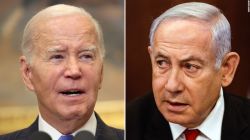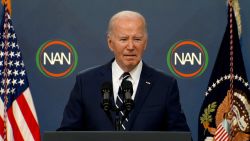There’s no question as to what President Donald Trump is trying to do with his new web video featuring a Mexican man bragging about killing two police officers and gleefully pledging to kill more if he ever can.
Trump is trying to use racial stereotypes – Luis Bracamontes as a crazy Hispanic criminal who slipped through the US border system – as a way to throw tar on a wide swath of Hispanics, including those currently traveling toward the United States’ southern border in a so-called caravan. He’s trying to scare people – Republicans in particular – to go vote on Tuesday or run the risk of having a whole lot more like Bracamontes coming to America.
It’s the sort of fear-mongering and race-baiting that both needs to be called out and calls back to one of the most notorious negative ads ever run: the Willie Horton commercial. The Americans for Bush arm of the National Security Political Action Committee, which supported President George H.W. Bush against Massachusetts Gov. Michael Dukakis in the 1988 race, ran the ad ostensibly as a commercial on the death penalty, which Bush favored and Dukakis opposed. The “star” of the ad was a man named Willie Horton – an African-American man with a goatee and an Afro. With an image of Horton on screen, a narrator described how Dukakis had allowed Horton out of prison on a weekend pass – and how Horton had kidnapped a couple, stabbed the man and repeatedly raped the woman.
The ad was decried – primarily in the years after it ran – as playing on the fears of whites that a black man looking like Horton could be out there, in their towns, if Dukakis won.
The similarity between the two videos is obvious: Both attempt to use a hardened minority criminal to scare people – primarily white people. But on several other important levels, the comparison between the Willie Horton ad and this new video from the Trump campaign breaks down. Here are a few key differences:
1. The Willie Horton ad ran in a presidential year and race: The Willie Horton ad dropped in the middle of the presidential race between Bush and Dukakis. The independent group’s ad corresponded with a prolonged effort by the Bush campaign to cast Dukakis as too liberal to be elected president. The Trump web video featuring Bracamontes emerged just six days before a midterm election. It’s not directed at a candidate at all; instead the writing on the screen reads, “Democrats let him into our country. Democrats let him stay.”
2. The Willie Horton ad was on TV: Obviously the idea of running an Internet-only video was not a thing way back in 1988. (ARPANET, the precursor to the modern Internet, was shelved in 1990.) So, obviously, the PAC had one way of pushing this message of Dukakis being soft on crime – with a very strong racial undertone – on TV. Which is a much bigger gamble than what Trump is doing with his ad. TV ad buys cost real money; they are consistently the single biggest expenditure in a presidential campaign. (Worth noting: The Horton ad – the one with his picture in it – ran for a relatively brief period of time). The web video made for Trump’s campaign, on the other hand, probably cost a few thousand dollars, beginning to end. (There are rumors that the campaign may take the ad to the TV airwaves; I’ll believe it when I see it.) Of course, the amount of pickup – largely negative – the ad has received from news coverage is worth plenty to the Trump campaign.
3. The Willie Horton ad was a clean hit: While the Horton ad was clearly intended to play at racial fears and animus, the actual opposition research it was passed on was broadly accurate. While Dukakis had inherited the weekend furlough program from the previous Republican governor (a guy named Francis Sargent), he hadn’t ended it soon enough to keep Horton from taking advantage of the program and committing the kidnapping, stabbing and rape. As negative ads go, it was fair. The Trump ad, on the other hand, seems to be trying to suggest that Democrats are responsible for Bracamontes’ murder of two cops. Though Bracamontes first entered the US illegally while Bill Clinton was president, he was also deported when Clinton was president. The final time he entered the country illegally – prior to his arrest for the murder of two police officers in 2014 – George W. Bush was president.
4. The Willie Horton ad was not immediately condemned for its racial overtones: The Horton ad ran for roughly a month on cable television networks. It wasn’t until it had been off the air for several weeks that Jesse Jackson said on CBS News that the ad was a clear attempt to play on racial fears. The obvious racial appeal of the Trump ad was called out almost instantaneously. (“Trump shocks with racist new ad days before midterms” read the headline on CNN’s website.) The video and the context about its clear racial message were inseparable.
There’s no question that Trump’s goal with the Bracamontes ad is the same as the goal of the Willie Horton ad: To invoke fear and, in so doing, to drive their voters to the polls. (Negative emotions like fear and anger tend to be bigger drivers for turnout than, say, hope and change.) But these efforts are not facsimiles of one another.



















